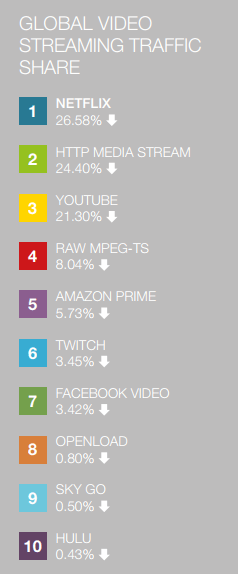 Openload, one of the largest file-hosting sites on the Internet, is a thorn in the side of many copyright holders.
Openload, one of the largest file-hosting sites on the Internet, is a thorn in the side of many copyright holders.
Content hosted on the site has served as a source for many pirate apps and sites. As a result, it recently earned a mention on United States Trade Representative list of “notorious” markets.
Today the site makes it onto another list, one that shows how much bandwidth the site is generating around the world.
The data come from Canadian broadband management company Sandvine, which just published its latest Global Internet Phenomena report. This provides an overview of which sites, applications, and protocols generate the most Internet traffic.
This list of traffic sources is dominated by video. Netflix is in the lead, with 14.97% of all downstream bandwidth, followed by the more generic HTTP Media Streaming (13.07%), and YouTube (11.35%). Overall, the video category is good for more than half of all bandwidth generated.
BitTorrent remains relevant too, especially on the upstream side. As we highlighted in a preview last week, torrent traffic is growing in some parts of the world, mostly due to piracy.
 When zooming in on downstream-video bandwidth, Openload comes into the picture. Sandvine’s data shows that the file-hosting site generates 0.8% of all video traffic online.
When zooming in on downstream-video bandwidth, Openload comes into the picture. Sandvine’s data shows that the file-hosting site generates 0.8% of all video traffic online.
That’s a massive amount of bandwidth, more than various legal streaming services such as Hulu or HBO Go use.
“One interesting appearance in the top 10 is Openload, which is #8 with 0.80% of video traffic worldwide ahead of services like Hulu, HBO Go, and BBC iPlayer with a service that likely will not make movie studios happy,” Sandvine writes.
This comparison is perhaps not entirely fair since, in contrast to the other services, Openload is available globally, but it clearly shows how much traffic a file-sharing site can generate.
There are significant differences in Openload’s ‘traffic share’ in various regions. Sandvine was kind enough to share some additional details that provide some further insight into this.
In the Asia Pacific region, 3.66% of all downstream traffic is credited to Openload, which makes it the 7th most used data source. In the EMEA and the Americas, the percentages are 0.79% and 0.39% respectively.
The massive interest in Openload and BitTorrent’s apparent comeback are signs that consumers still see the need to access entertainment through unofficial channels. According to Sandvine, the increased fragmentation of online video is one of the reasons. People don’t want to pay for a handful of subscription services.
“With more content choices and channels than ever before, consumers do not have good options to get access to all the content that may interest them and are still resorting to piracy,” Sandvine writes in its report.
While Openload is generally characterized as a piracy site, the site’s operators have rejected this notion. Instead, they point out that they have a DMCA-compatible takedown policy.
“We are offering several methods of taking down files according to the DMCA law, which is practically a standard in the whole world,” Openload previously said.





